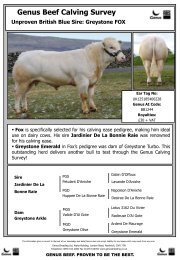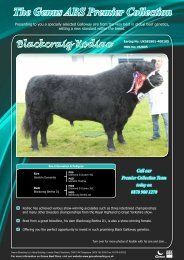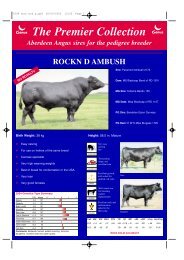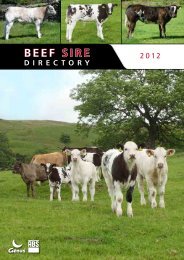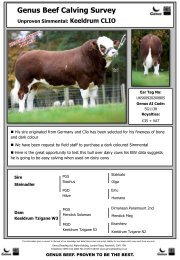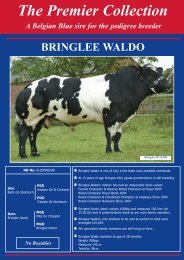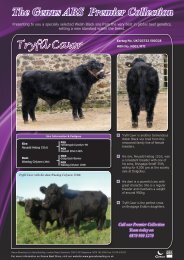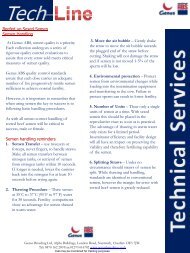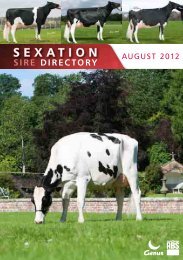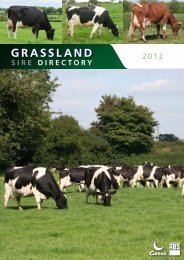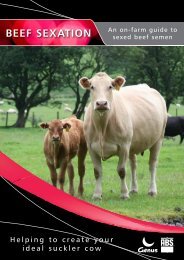Front cover - Genus UK website
Front cover - Genus UK website
Front cover - Genus UK website
- No tags were found...
You also want an ePaper? Increase the reach of your titles
YUMPU automatically turns print PDFs into web optimized ePapers that Google loves.
GENOMICS<br />
What are genomic evaluations<br />
Genomics is the science of evaluating DNA of an animal to give an indication of the potential that animal<br />
could achieve. With enough information, it is possible to see clear associations emerge between the<br />
animals genome and their actual performance. Through knowledge of these associations, genomic<br />
evaluations have been developed. Genomic evaluations are, like traditional genetic evaluations, calculated<br />
from a blend of information.<br />
We at <strong>Genus</strong> ABS have been using genomic evaluations for some time to help select the next generation<br />
of bulls for progeny testing, giving us extra confidence in our selections with a view to graduating more<br />
high quality sires than ever before. In addition, we are marketing elite young bulls that possess superior<br />
genomic values from reputable cow families and first-class sire stacks. For information on the genomic<br />
young bulls we currently have available please speak to your <strong>Genus</strong> ABS representative or look at our<br />
<strong>website</strong> www.genusbreeding.co.uk.<br />
Using genomic evaluated bulls...<br />
Farmers are advised to carefully consider the reliability of the index and establish whether a bull has<br />
milking daughters. Genomic indexes have reliabilities somewhere between 55 to 65%. When more<br />
information goes into the calculation of the genomic index and when the heritability of the trait is high, the<br />
reliability will be higher. The lower the reliability of the index, the greater the chance the index will change.<br />
What proportion of genomic bulls should be used in my herd<br />
Any low reliability bull should be used with caution. It depends on how<br />
much risk you like to take, you may prefer the security of using only<br />
second crop, high reliability bulls (highlighted between pages 3 and 9<br />
of this Directory). Genomics needs to be used as part of a considered<br />
breeding programme. At <strong>Genus</strong> ABS we recommend you use a team<br />
of bulls to spread the risk using genomic young sires.<br />
The graph opposite from DairyCo gives a rough guide to the recommended<br />
usage of semen from individual bulls at different levels of reliability.<br />
In practice this means that no more than 12.5% should be bred to a<br />
genomically evaluated young bull. It is best to use a mix of<br />
daughter-proven and young genomically evaluated bulls to obtain<br />
a balance between risk and reward.<br />
Please speak to a <strong>Genus</strong> ABS Breeding advisors for more information<br />
and advice.<br />
Source:<br />
Genomics<br />
Genomics<br />
1st Crop Sires<br />
2nd Crop sires<br />
Dairy Sire User Guide<br />
Somatic Cell Count<br />
An important trait for<br />
breeding cows with<br />
mastitis resistance for<br />
future generations. The<br />
range for sires marketed in<br />
the <strong>UK</strong> is effectively +30%<br />
(poor) to -30% (good).<br />
Direct Calving Ease<br />
and Maternal<br />
Calving Ease<br />
Direct calving ease<br />
predicts the ease with<br />
which a calf by that sire<br />
will be born. Maternal<br />
calving ease predicts the<br />
Available<br />
as<br />
sexed<br />
semen<br />
dtrs: Glanmarton Bossman Betty, second lactation<br />
HOMESTEAD<br />
ease with which a daughter<br />
of that sire will give birth<br />
to her own calf.<br />
Daughter Fertility<br />
Index<br />
FITNESS TRAITS<br />
1st crop sires<br />
TYPE ASSESSMENT PROOF<br />
13<br />
BOSSMAN<br />
Direct Calving Ease+0.3%<br />
Unsuitable<br />
for heifers<br />
Lifespan +0.3<br />
Suitable<br />
for heifers<br />
Maternal Calving Ease +0.7<br />
Below<br />
Average<br />
Somatic Cell Count -1%<br />
Available<br />
as<br />
sexed<br />
semen<br />
A measure of female<br />
fertility. The average of all<br />
marketed bulls is 0. Each<br />
point increase in fertility is<br />
worth half a day in calving<br />
• An exceptional milk bull with great cell count improvement.<br />
interval. The majority of<br />
bulls would fall between<br />
(poor)-15 to +15(good).<br />
Above<br />
Average<br />
HOLSTEIN<br />
Bassingthorpe BOSSMAN EX95 TV BYF<br />
HBN: 0100632428 <strong>Genus</strong> ABS Code: FH2740<br />
The new British legend with record setting locomotion.<br />
Goldwyn x VG87 Stormatic x VG89 Durham<br />
Bomaz HOMESTEAD TV BYF<br />
Locomotion +4.36<br />
HBN: 65000132474096 <strong>Genus</strong> ABS Code: FH2661<br />
Above<br />
Hershel x Finale Average x Highlight<br />
Below<br />
Average<br />
Temperament +0.87<br />
Average<br />
Production Figures<br />
Body Condition -1.07<br />
Daughter Fertility Index +0.2 Milking Speed +1.88<br />
PTA2010 August 2012<br />
Below Source: DairyCo breeding+<br />
Above<br />
dtr: Parkhead Bossman 82, second lactation<br />
PLI2012 £38 PIN2012 £13<br />
*N/A = Data Not Available<br />
Milk kg +599<br />
Fat +16.4 -0.09%<br />
Linear Assessment August 2012<br />
kg<br />
Source:<br />
Protein kg PTA2010 August 2012<br />
74 Daughters 47 Herds Reliability 89% <strong>UK</strong><br />
99% Reliability<br />
+9.2 -0.12%<br />
Daughters 5466 Herds 886 Source: DairyCo breeding+<br />
-3 -1 0 +3<br />
-2 +1 +2<br />
TYPE MERIT Poor<br />
-0.1 2.90 Excellent SCC -22%<br />
Lifespan<br />
MAMMARY Poor<br />
2.01 Excellent MCE -0.2% DCE -1.0%<br />
PLI2012 £148 PIN2012 £26<br />
DFI -8.4<br />
LEGS/FEET Poor<br />
3.59 Excellent<br />
April Linear Assessment 2012<br />
Stature<br />
Short<br />
69 2.81 Herds Tall<br />
Source:<br />
Milk MACE kg +567<br />
134 Daughters Reliability 78%<br />
Chest width Narrow<br />
-3 -2<br />
Poor -0.42 Wide<br />
TYPE MERIT<br />
1.86 Excellent<br />
Body depth Shallow<br />
Poor<br />
Poor 1.39 Deep<br />
MAMMARY<br />
LEGS/FEET<br />
Angularity Thick<br />
Short<br />
Narrow 1.59 Angular<br />
Stature<br />
Chest width<br />
1.95 Excellent<br />
0.56 Excellent<br />
Fat 0.79 Tall kg<br />
-0.08 Wide<br />
+19.3 -0.04%<br />
Rump width Narrow<br />
Shallow<br />
Thick<br />
0.64 Wide<br />
Body depth<br />
0.00 Deep<br />
Angularity<br />
Rump angle High pins<br />
Narrow<br />
-0.53 Sloped<br />
1.69 Angular<br />
1.10 Wide<br />
Protein<br />
1.70 Sloped<br />
kg +15.0 -0.04%<br />
Rump width<br />
Rump angle<br />
Rear legs<br />
Straight<br />
High pins<br />
Straight -0.98 Sickle<br />
Rear legs<br />
-0.70 Sickle<br />
Foot angle<br />
Foot angle Low<br />
Low<br />
Loose 1.78 Steep<br />
Fore udder<br />
Fore udder Loose<br />
Low<br />
Broken 1.59 Strong<br />
Rear udder<br />
Udder support<br />
1.28 Steep<br />
1.82 Strong<br />
Reliability 1.78 High<br />
2.66 Strong<br />
95%<br />
Rear udder Low<br />
Deep<br />
Wide 2.02 High<br />
Udder depth<br />
1.34 Shallow<br />
<strong>Front</strong> teat pl<br />
3.01 Close<br />
Udder support Broken<br />
Short<br />
Apart<br />
1.01 Strong<br />
-1.08 Long<br />
Beta 2.38 CloseCasein<br />
A2/A2<br />
Teat length<br />
Rear teat pl<br />
Udder depth Deep<br />
1.32 Shallow<br />
Dtr: Northstar Homestead 15303<br />
<strong>Front</strong> teat pl Wide<br />
1.37 Close<br />
Teat length Short<br />
-1.79 Long<br />
Daughters 121 Herds 73<br />
Rear teat pl Apart<br />
0.99 Close<br />
PRODUCTION FIGURES<br />
ROCK SOLID<br />
GENETICS<br />
SEMEN<br />
FERTILITY<br />
HIGH<br />
TYPE<br />
<strong>UK</strong><br />
PROVEN<br />
DAUGHTER<br />
FERTILITY<br />
Symbols<br />
Helps to highlight a bulls<br />
Global key strengths. No.1 Type A Bolton full son, expect stunnin<br />
description of the symbols Bolton and the B<br />
are available on page 2.<br />
PTA2010<br />
(Predicted<br />
Transmitting Ability)<br />
The PTA is the predicted<br />
level of production, above<br />
or below the base, which<br />
the animal is capable of<br />
passing on to its offspring.<br />
PIN2012<br />
(Profit Index)<br />
PIN is a measure of<br />
the efficiency of milk<br />
production calculated from<br />
genetic indices. Expressed<br />
as a financial value, PIN<br />
predicts additional margin<br />
over feed, which a bull is<br />
expected to pass onto it’s<br />
progeny.<br />
Dos and don’ts of genomic indexes<br />
Do...<br />
• Carefully study the bull’s index, just as though<br />
he were a conventionally tested sire.<br />
• Remember that the lower the reliability of the<br />
index, the greater the chance the index will<br />
change.<br />
• Ask your AI company to show you how many<br />
daughters the bull has and in how many herds.<br />
• Use a mix of daughter-proven and young<br />
genomically evaluated bulls to obtain a balance<br />
between risk and reward.<br />
Don’t...<br />
• Over-estimate the reliability of genomic indexes<br />
which will be lower than those of most progeny<br />
tested bulls.<br />
• Over-use any young, low reliability bull with or<br />
without a genomic index.<br />
And remember...<br />
• There’s nothing mystical about genomic<br />
evaluations in themselves. A young bull<br />
marketed as a ‘genomic young sire’, may be not<br />
better or worse than any other bull<br />
Lifespan<br />
A direct measure of how<br />
long cows are lasting in<br />
the herd. Each decimal<br />
point reflects an extra<br />
month of herd life.<br />
Linear Assessment<br />
Linear measures the difference in<br />
biological extremes in different traits,<br />
without saying which is the most<br />
desirable score. The mid point (0)<br />
represents the breed average for the<br />
population.<br />
Production daughters in herds<br />
At <strong>Genus</strong> ABS our aim is to achieve 100<br />
daughters in 60 herds early in a bulls<br />
life (Rock Solid Status). This spread of<br />
milking daughters gives us the confidence<br />
that a bulls proof will accurately reflect<br />
the results seen on farm, and not change<br />
significantly over time.<br />
PLI2012<br />
Helps farmers select<br />
the correct balance of<br />
longevity fertility, somatic<br />
cell count and production<br />
improvement (PIN).<br />
Recent research shows that<br />
for every £1 increase in a<br />
cows PLI, a £4.21 increase<br />
in margin results.



